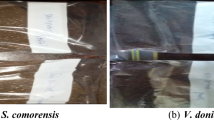Abstract
Pitaya is one of the most produced tropical fruits in Turkey because of its high economic value. Seeds of this fruit consumed with fruit are an important source due to nutritional and health benefits. In this study mineral and ash content of pitaya seeds were investigated. The research was carried out with two different species of pitaya, Hylocereus undatus (H. undatus) and Hylocereus polyrhizus (H. polyrhizus), which have red shell. H. undatus has a white pulp color while H. Polyrhizus has a red. The ash content of H. polyrhizus and H. undatus pitaya seeds was 2.78% and 4.09%, respectively. The main minerals detected in H. polyrhizus and H. undatus pitaya species were potassium (36.47 mg/kg and 31.99 mg/kg), magnesium (9.15 mg/kg and 9.16 mg/kg), phosphorus (8.99 mg/kg and 8.08 mg/kg), sulphur (6.11 mg/kg and 5.48 mg/kg) and calcium (2.17 mg/kg and 1.90 mg/kg). Mineral content of seeds of H. polyrhizus and H. undatus species were found similar to the pitaya species grown in different tropical countries.

Similar content being viewed by others
References
Association of Official Analytical Chemists—AOAC (1997) Official methods of analysis. Association of official analytical chemists, IAC, Arlington
Britton NL, Rose JN (1963) The Cactaceae: descriptions and illustrations of plants of the cactus family vol 3. Courier Corporation,
Chemah TC, Aminah A, Noriham A, Aida WWM (2010) Determination of pitaya seeds as a natural antioxidant and source of essential fatty acids. Int Food Res J 17(4):1003–1010
Durmuş E, Yiğit A (2003) Türkiye’nin meyve üretim yöreleri. Fırat Univ J Soc Sci 13(2):23–54
Esquivel P, Stintzing FC, Carle R (2007) Comparison of morphological and chemical fruit traits from different pitaya genotypes (Hylocereus sp.) grown in Costa Rica. J Appl Bot Food Qual 81(1):7–14
Gunasena HP, Pushpakumara DKNG, Kariawasam M (2007) Dragon fruit. Underutilized Fruit Trees Sri lanka 1:110–140
Jamilah B, Shu CE, Kharidah M, Dzulkily MA, Noranizan A (2011) Physico-chemical characteristics of red pitaya (Hylocereus polyrhizus) peel. Int Food Res J 18(1):279–286
Jerônimo MC, Orsine JVC, Borges K, Novaes MRCG (2015) Chemical and physical-chemical properties, antioxidant activity and fatty acids profile of red Pitaya [Hylocereus undatus (haw.) Britton & Rose] grown in Brazil. J Drug Metab Toxicol 6(4):1–6
Kansci G, Koubala BB, Mbome IL (2008) Biochemical and physicochemical properties of four mango varieties and some quality characteristics of their jams. J Food Process Preserv 32(4):644–655
Khalili RMA, Norhayati AH, Rokiah MY, Asmah R, Nasir MM, Muskinah MS (2006) Proximate composition and selected mineral determination in organically grown red pitaya (Hylocereus sp.). J Trop Agric Food Sci 34(2):269
Khalili RMA, Norhayati AH, Rokiah MY, Asmah R, Muskinah MS, Manaf AA (2009) Hypocholesterolemic effect of red pitaya (Hylocereus sp.) on hypercholesterolemia induced rats. Int Food Res J 16:431–440
Lalita B, Sanjib KS, Biplab KN (2007) Food-based nutrition strategies in Bangladesh. Experience of integrated horticulture and nutrition development. FAO, Thailand
Le Bellec F, Vaillant F (2011) Pitahaya (pitaya) (Hylocereus spp.). In: Postharvest biology and technology of tropical and subtropical fruits: Mangosteen to white Sapote, pp 247–273e
Le Bellec F, Vaillant F, Imbert E (2006) Pitahaya (Hylocereus spp.): a new fruit crop, a market with a future. Fruits 61(4):237–250
Liaotrakoon W (2013) Characterization of dragon fruit (Hylocereus spp.) components with valorization potential. Doctoral dissertation, Ghent University
Lim HK, Tan CP, Karim R, Ariffin AA, Bakar J (2010) Chemical composition and DSC thermal properties of two species of Hylocereus cacti seed oil: Hylocereus undatus and Hylocereus polyrhizus. Food Chem 119(4):1326–1331
McMahon G (2003) Pitaya (dragon fruit). Department of primary industry, fisheries and mines. Crop For Hortic Div Darwin NT Fact Sheet 12:2
National Institutes of Health (2018) http://ncbi.nlm.nih.gov/books/NBK56068/. Accessed 5 Feb 2019
Prakash D, Upadhyay G, Gupta C, Pushpangadan P, Singh KK (2012) Antioxidant and free radical scavenging activities of some promising wild edible fruits. Int Food Res J 19(3):1109–1116
Raveh E, Nerd A, Mizrahi Y (1998) Responses of two hemiepiphytic fruit crop cacti to different degrees of shade. Sci Hortic 73(2–3):151–164
Sajib MAM, Jahan S, Islam MZ, Khan TA, Saha BK (2014) Nutritional evaluation and heavy metals content of selected tropical fruits in Bangladesh. Int Food Res J 21(2):609–6015
Schweiggert RM, Villalobos-Gutierrez MG, Esquivel P, Carle R (2009) Development and optimization of low temperature enzyme-assisted liquefaction for the production of colouring foodstuff from purple pitaya (Hylocereus sp.[Weber] Britton & Rose). Eur Food Res Technol 230(2):269–280
Skujins S (1998) Handbook for ICP-AES (Varian-vista), a short guide to vista series ICP-AES operation. Var Int Ag Zug version 1.0:235–248
Stintzing FC, Schieber A, Carle R (2002) Betacyanins in fruits from red-purple pitaya, Hylocereus polyrhizus (Weber) Britton & Rose. Food Chem 77(1):101–106
To LV, Ngu N, Duc ND, Trinh DTK, Thanh NC, Mien DVH, Hai CN, Long TN (1999) Quality assurance system for dragon fruit. The Australian Centre for International Agricultural Research Proceedings 100, 11 Opening Address 12, Ho Chi Minh City
Truong NM, Dang QT (2016) Application of hydrolytic enzymes for improvement of red dragon fruit juice processing. Asia Pac J Sustain Agric Food Energy 4(1):1–4
Valiente-Banuet A, Gally RS, Arizmendi MC, Casas A (2007) Pollination biology of the hemiepiphytic cactus Hylocereus undatus in the Tehuacán Valley, Mexico. J Arid Environ 68(1):1–8
Villalobos-Gutiérrez MG, Schweiggert RM, Carle R, Esquivel P (2012) Chemical characterization of Central American pitaya (Hylocereus sp.) seeds and seed oil. CyTa J Food 10(1):78–83
Vy LTT (2014) Study on bioactivities of Hylocereus undatus seed extracts: Antioxidant activities and determination of its essential fatty acids. Doctoral dissertation, International University, Vietnam
Funding
This study was supported by the Scientific Research Projects (BAP) of Karamanoğlu Mehmetbey University, Karaman-Turkey (39-M-16).
Author information
Authors and Affiliations
Corresponding author
Ethics declarations
Conflict of interest
N.M. Nizamlioğlu, A. Ünver and Ç. Kadakal declare that they have no competing interests.
Rights and permissions
About this article
Cite this article
Nizamlıoğlu, N.M., Ünver, A. & Kadakal, Ç. Mineral Content of Pitaya (Hylocereus polyrhizus and Hylocereus undatus) Seeds Grown in Turkey. Erwerbs-Obstbau 63, 209–213 (2021). https://doi.org/10.1007/s10341-021-00561-x
Received:
Accepted:
Published:
Issue Date:
DOI: https://doi.org/10.1007/s10341-021-00561-x




